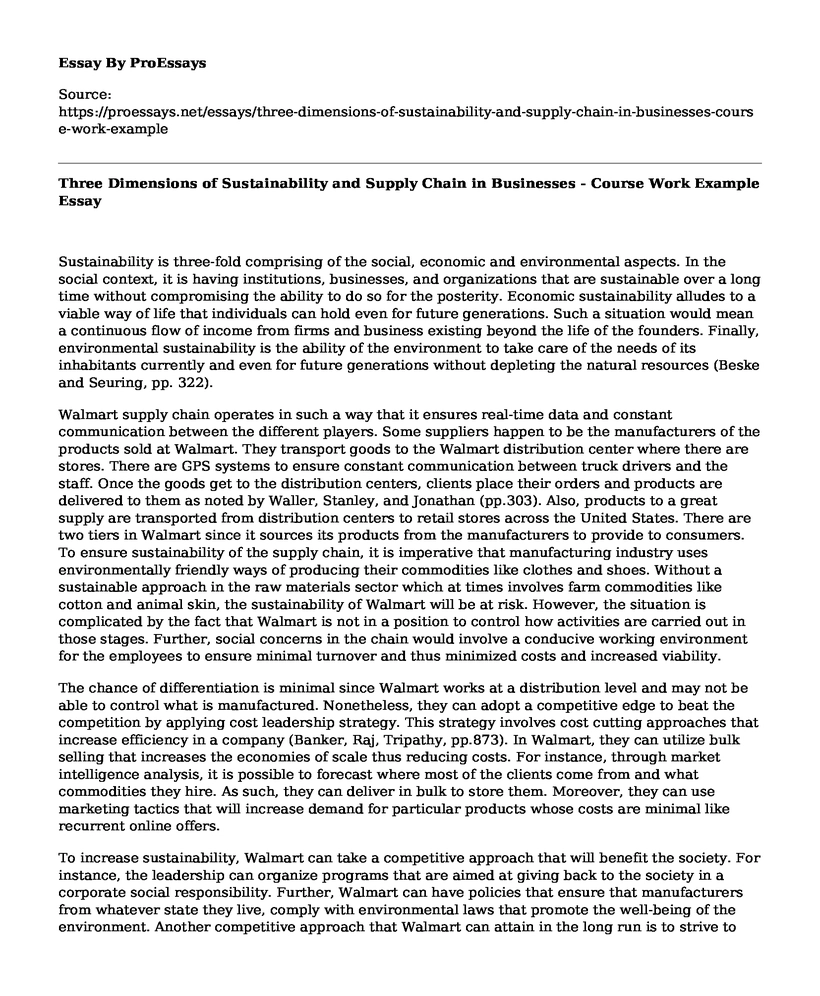Sustainability is three-fold comprising of the social, economic and environmental aspects. In the social context, it is having institutions, businesses, and organizations that are sustainable over a long time without compromising the ability to do so for the posterity. Economic sustainability alludes to a viable way of life that individuals can hold even for future generations. Such a situation would mean a continuous flow of income from firms and business existing beyond the life of the founders. Finally, environmental sustainability is the ability of the environment to take care of the needs of its inhabitants currently and even for future generations without depleting the natural resources (Beske and Seuring, pp. 322).
Walmart supply chain operates in such a way that it ensures real-time data and constant communication between the different players. Some suppliers happen to be the manufacturers of the products sold at Walmart. They transport goods to the Walmart distribution center where there are stores. There are GPS systems to ensure constant communication between truck drivers and the staff. Once the goods get to the distribution centers, clients place their orders and products are delivered to them as noted by Waller, Stanley, and Jonathan (pp.303). Also, products to a great supply are transported from distribution centers to retail stores across the United States. There are two tiers in Walmart since it sources its products from the manufacturers to provide to consumers. To ensure sustainability of the supply chain, it is imperative that manufacturing industry uses environmentally friendly ways of producing their commodities like clothes and shoes. Without a sustainable approach in the raw materials sector which at times involves farm commodities like cotton and animal skin, the sustainability of Walmart will be at risk. However, the situation is complicated by the fact that Walmart is not in a position to control how activities are carried out in those stages. Further, social concerns in the chain would involve a conducive working environment for the employees to ensure minimal turnover and thus minimized costs and increased viability.
The chance of differentiation is minimal since Walmart works at a distribution level and may not be able to control what is manufactured. Nonetheless, they can adopt a competitive edge to beat the competition by applying cost leadership strategy. This strategy involves cost cutting approaches that increase efficiency in a company (Banker, Raj, Tripathy, pp.873). In Walmart, they can utilize bulk selling that increases the economies of scale thus reducing costs. For instance, through market intelligence analysis, it is possible to forecast where most of the clients come from and what commodities they hire. As such, they can deliver in bulk to store them. Moreover, they can use marketing tactics that will increase demand for particular products whose costs are minimal like recurrent online offers.
To increase sustainability, Walmart can take a competitive approach that will benefit the society. For instance, the leadership can organize programs that are aimed at giving back to the society in a corporate social responsibility. Further, Walmart can have policies that ensure that manufacturers from whatever state they live, comply with environmental laws that promote the well-being of the environment. Another competitive approach that Walmart can attain in the long run is to strive to penetrate new markets in other regions that have not been exploited previously. With these three methods, holistic sustainability will be realized.
Works Cited
Beske, Philip, and Stefan Seuring. "Putting sustainability into supply chain management." Supply Chain Management: an international journal 19.3 (2014): 322-331.
D. Banker, Rajiv, Raj Mashruwala, and Arindam Tripathy. "Does a differentiation strategy lead to more sustainable financial performance than a cost leadership strategy?." Management Decision 52.5 (2014): 872-896.
Waller, Matthew A., Stanley E. Fawcett, and Jonathan L. Johnson. "The Luxury Paradox: How Systems Thinking and Supply Chain Collaboration Can Bring Sustainability Into Mainstream Practice." Journal of Business Logistics 36.4 (2015): 303-305.
Cite this page
Three Dimensions of Sustainability and Supply Chain in Businesses - Course Work Example. (2021, Jun 24). Retrieved from https://proessays.net/essays/three-dimensions-of-sustainability-and-supply-chain-in-businesses-course-work-example
If you are the original author of this essay and no longer wish to have it published on the ProEssays website, please click below to request its removal:
- Introduction to Ethics in Decision Making
- The Great Man Theory Essay
- Ethical and Legal Issues While Designing and Managing an Enterprise Network
- Essay Sample on Risk Management & Mitigation Strategies: Accepting, Transferring & Avoiding
- Essay Example on Understanding Consumer Behaviour: Microeconomic Theory
- Nike vs Reebok: Athletic Shoes Industry Competition Analysis
- Performance Evaluation: Crucial Process for Organizational Success - Paper Sample







